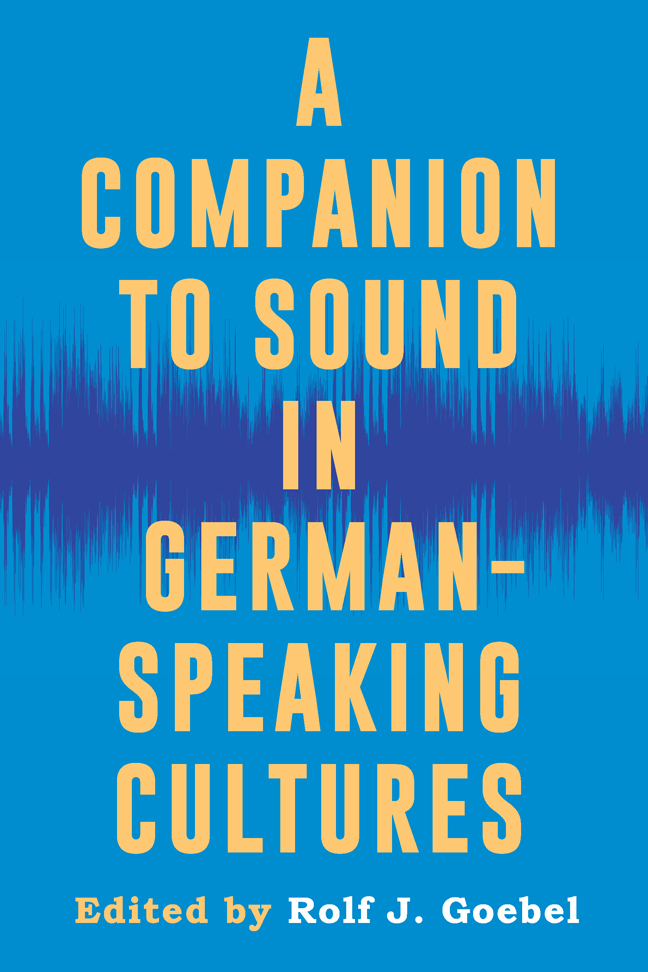Book contents
- Frontmatter
- Contents
- List of Illustrations
- Preface
- Introduction
- Part I Sonic Practices from the Middle Ages to the Nineteenth Century
- Part II Rediscovering the Sounds of Modernism
- Part III Listening to the Unbearable: The Sounds of National Socialism and the Holocaust
- Part IV After the Catastrophe: Sounds in Postwar Germany and Beyond
- Part V Sounds of the Present
- Part VI Epilogue
- Select Bibliography and Further Reading
- Notes on the Contributors
- Index
2 - A German Dance: Music, Mesmerism, and the Glass Armonica
Published online by Cambridge University Press: 21 February 2024
- Frontmatter
- Contents
- List of Illustrations
- Preface
- Introduction
- Part I Sonic Practices from the Middle Ages to the Nineteenth Century
- Part II Rediscovering the Sounds of Modernism
- Part III Listening to the Unbearable: The Sounds of National Socialism and the Holocaust
- Part IV After the Catastrophe: Sounds in Postwar Germany and Beyond
- Part V Sounds of the Present
- Part VI Epilogue
- Select Bibliography and Further Reading
- Notes on the Contributors
- Index
Summary
I. Introduction
In 1825 Franz Schubert participated in a session of music therapy for a young woman suffering from a mental disorder. The treatment was based on the principles of mesmerism, the proto-hypnotic healing technique devised by Franz Anton Mesmer in the later eighteenth century to straighten out the body's invisible life fluid, or “animal magnetism.” The incident is surprisingly representative of a broader interest in the power of sound, especially in German-speaking Europe. The piano music Schubert played on the occasion connects not only to mesmerism, but also to the uses of another still-recent instrument, the glass armonica; to speculations on mechanical instruments by E. T. A. Hoffmann; to music by Mozart and Beethoven; and to Rilke's early twentieth-century response to the phonograph. But the common thread in this network is not music at all. It is a certain sound: a primordial undertone that must be understood as omnipresent but that becomes audible only under special circumstances.
In accord with my book The Hum of the World, I will refer to that primary sound here as “the audiable” (audible with a resonant extra vowel sound). The coinage marks the difference between the sounds you hear and the sensory awareness of sounds that flow through and support the sounds you hear. The audiable is the “hum” of my book's title. It forms a continuous background not only to hearing but also to sense perception in general. We do not normally hear the audiable as a distinct sound, but it is a genuine auditory phenomenon. For a visual analogy, we might turn to things seen best when we look at them from the corner of an eye. Such averted vision makes faint objects more discernible. The constellation Pleiades, for example, is almost invisible if you try to stare at it, but evocatively present if you look askance. The audiable is usually best observed with what we might call averted hearing. Its presence resonates through other sounds at or near the threshold of audibility that temporarily blend with it. That is what happens in Schubert's piano piece, and to the sounds in what we might call its auditory intertext.
II. Therapeutic Resonance: The Piano Pedal
The documentation concerning Schubert's therapeutic session is scanty, and so is what we know about the patient, Louise Mora.
- Type
- Chapter
- Information
- A Companion to Sound in German-Speaking Cultures , pp. 36 - 52Publisher: Boydell & BrewerPrint publication year: 2023



